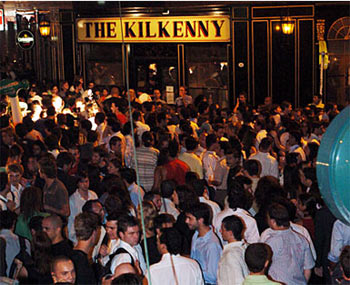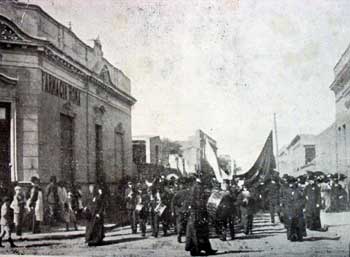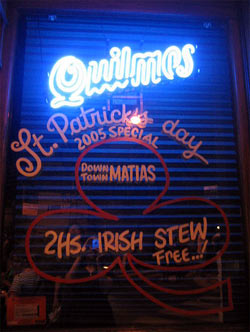|
Furthermore, one of the distinctive features of the
celebrations on the streets of Buenos Aires was the radical
heterogeneity of the artistic displays. Such heterogeneity was
evidenced by the diversity of the mini-musical shows (murgas,
rock music, Scottish bagpipes) related to different ethnic and
social backgrounds, which may be seen as indicators of the
lack of a ‘clear’ and ‘unique’ shared social identity. The
distinction from liturgical celebrations, and in this case
from Celtic festivals, is more obvious if we consider the
scarcity of icons representative of Ireland, such as shamrocks
and leprechauns, together with the relative absence of the
marketing of identifying symbols of the community. In this
sense, the street celebrations of St. Patrick’s Day show a
multicultural and pluriethnic convergence which cohabits in
Buenos Aires in a plural mosaic of identities.
|

A crowd celebrating St.
Patrick's Day at Reconquista street,
downtown Buenos Aires
(Infobae.com,
18 March 2006)
|
In
reference to the street celebrations of 2006, we find the same
numerous attendance, but with a greater active police presence
and barriers that officially marked the public celebration
area. In this way, the intervention of local state bodies in
the public festivities can be registered, in part, into the
framework of policies of multiculturalism and citizenship (Canale
2006). In parallel, this state cultural policy is linked to
the plea for regulation, demanded as much by the Irish
community – in its claim of a distancing and usurpation of
traditions – as by the residents of the area, of the
‘incidents’ which took place in 2005 and which were
recontextualised by the media that year in the debate on ‘lack
of safety’, as we will examine in more depth below.
St.
Patrick’s Day 2006 and the rhetoric of safety
The
celebrations of 2006 showed signs of the impact of an
intertextual network of debates about the absence of security,
[3] initiated by media campaigns sparked off by, among others, the
case of the kidnap and murder of Axel Blumberg and the tragedy
of the young people who died in the Buenos Aires nightclub
Cromañón. The latter event, which led to the political trial
and subsequent dismissal from office of the governor of Buenos
Aires, Dr Aníbal Ibarra, set the scene for a debate about the
city government’s safety mechanisms, which could be seen in
the discursive construction of the news surrounding the St.
Patrick’s Day celebrations. Thus the Buenos Aires morning
edition of Clarín newspaper reported on the
celebrations under the headline ‘St. Patrick’s Day: without
incidents, but several closures’, focusing attention on the
control mechanisms put into operation for the celebrations. In
this way the news report stressed that ‘This time, aiming to
avoid incidents, the sale of alcohol on the street was
banned...’ and ‘by order of the public prosecutors... 1,100
cans [of beer]… were seized... charges were filed against 40
people … The Security Department of the Government of Buenos
Aires informed the press that it had closed … shops… selling
alcohol… and 5 bars… for … violating the Buenos Aires law…
which regulates safety in nightclubs’. The construction of a
semantic field surrounding regulation and punishment for any
infringement associated with the excessive consumption of
alcohol which gives rise to out-of-control behaviour is
evident here. The enumerative style, in which the accumulation
of details relating to punishments dominate along with the
mention of the security authorities, articulates this semantic
field drawn around regulation, constructed from the antithesis
regarding the excesses of 2005, implied in the temporal
sintagma ‘This time’. The use of the typographic tool of bold
lettering is also orientated towards highlighting this
rhetorical effect, and also intensified by the attention given
to the discourse of the image. The article includes a
photograph depicting a police officer in a medium shot
profile, accompanied by others, whose function, stressed in
the paratext which accompanies the photograph (‘A number of
police officers patrolled the streets in the traditional
celebration’), is to ensure the safety of the street
celebrations. All these elements contribute to the discursive
construction of this ‘rhetoric of control’ which marked the
celebrations of 2006.
|

St Patrick's Day in Luján,
1912
(The Southern Cross, 22 March 1912)
|
The St.
Patrick’s Day celebrations according to The Southern Cross
newspaper
In March
2006, the local newspaper The Southern Cross, the Irish
community’s means of media circulation in Argentina, summed up
in the motto ‘expressing our Argentine plenitude, from our
Irish ancestry’ published an editorial in an exhortative tone,
entitled ‘May St. Patrick’s Day return to being an Irish
festival’, signed by F. O´Killian, a contributor to the
newspaper. In a clearly endo-groupal positioning, tied to the
‘genuine’ tradition of ‘the Irish blood which flows through
all the descendants of far-distant Erin’, the article exhorts,
using the inclusive ‘we’ which establishes a differentiation
regarding the exo-group of non-Irish, to ‘clean up our image’,
rectifying the lack of control of the street celebrations and
alcohol consumption, associating its dangers with the tragic
events of Cromañón. In this way the article’s author demands
‘safety and regulation’ from the authorities of the Government
of Buenos Aires, and closes the article by establishing a
distinction between an ‘authentic Irish gathering in Adrogué’
which corresponds to ‘the style of origin, in a safe and
respectful atmosphere’, and ‘the other’ which ‘cannot continue
like this’. Using the rhetorical tool of antithesis, the
author requests ‘responses and proposals’ in order to achieve
a transformation in the way it is celebrated. The context of
this editorial corresponds to a front page article on ‘St.
Patrick’s Day. The thousand ways to celebrate it’, from Dublin
to Boston and New York, to Munich and Tokyo, to Luján,
Mercedes, Lincoln and Capilla del Señor (Province of Buenos
Aires), and from the ‘Solemn Mass’ of the ‘Patron Saint’ to
the ‘street shows and beer’ which ‘are shown by the media’.
This context, which also includes an agenda of celebrations
subscribed to by the Federation of Irish-Argentine Societies,
connects the canonical religious celebration of the ‘Mass
celebrated in honour of St. Patrick’ to emblems of nationality
like the ‘tributes’ to ‘General Don José de San Martín’ and to
‘Admiral Don Guillermo Brown’ and with the ‘social gathering’
of the Irish community in St. Brendan’s College. All of these
elements demonstrate the metaphorical concentration of ethnic
and religious meanings around the emblematic figure of St.
Patrick, united in a dynamic between endo-group and exo-group,
linked to a distinction between ‘genuine’ and ‘spurious
tradition’ to use Handler and Linnekin’s (1984) terms. Such
aspects serve as a framework for a debate on the safety and
control discourse, associated with the
excesses of the street celebrations, inserted into an
intertextual web which gives rise to a kind of ‘rhetoric
demanding social regulation’ into which the discourses
surrounding the Cromañón catastrophe can also be placed. Our
hypothesis maintains that this rhetoric produced some
modifications in the forms of celebration in 2006, in relation
to those we documented in 2005.
|

Beer advertising at a public
house in Buenos Aires, 17 March 2005
|
Advertising discourse on St. Patrick’s Day
The impact
of graphic advertising in the St. Patrick’s Day street
celebrations, which unite five thousand participants, is
becoming more and more notorious for the dimensions it has
attained in the last four years. For this reason in this
section we will try to explore the dynamic which supports the
celebration on the streets on the day of Ireland’s patron
saint. As this feast day is considered a commercial event, we
will take into account the strategies of group identification
used as means of persuasion which, in advertising narrative
discourse, are associated with the Irish community. Broadening
the concept of a commercial event, the advertising takes
elements susceptible to being recognised by the wider public.
These elements put forward as identifying are based on the
supposed representations to which the potential audience it is
directed towards relates, in this case, Irish identity.
Furthermore, we understand that advertising ‘campaigns’ as
concentrated, intensive actions, designed to achieve an
objective, which not only refers to the sale of a product but,
also to achieving the desired effect in a section of the
population, namely the sale of a behaviour, through the use of
discursive strategies (Kaplún 1997). We also highlight that a
particular feature of these discourses is the homogenisation
of diversity, for example, the term ‘Celtic’ as a signifier in
the advertisements is used in different contexts with distinct
meanings. The purpose of this strategy is manipulation
starting with the convergence of plurality in synthetic
expressions which are repeated, stripping the message of
nuance and complexity so that it may be effectively
appropriated by the public.
In recent
times, a diverse range of beer brands have been launched onto
the market, like Warsteiner, one of the beers that
achieved greatest coverage on the streets of downtown Buenos
Aires in the week leading up to 2005’s celebrations. This
company, together with the Guinness brand, sponsored
the beer party in what were considered the ‘sweet times’ of
the ‘dollar-peso one to one’. [4]
In the
campaign that they used, Warsteiner’s graphics stand
out as the bottle of beer is taken as a religious symbol. In
an iconic subversion with liturgical associations through
which the product is worshipped, the religious element is
subverted by worshipping alcohol. Furthermore, these graphics
were displayed on the streets, especially in the ‘La City’
area of Buenos Aires, attempting to attract the prospective
attendees (or clients) who get together to celebrate the day
by drinking beer on the streets and in the pubs. Thus these
advertising narratives, drawing on an important iconic
foundation, based on the burlesque reversion of the saint’s
day, contain, in their semiotic game, another implicit
narrative which is considered so popular that it can form part
of ‘what is not said’: the saint ‘is’ the emblem of a
community commonly associated with alcohol; and this saint
‘is’ beer’s paradigm. This element implied by the
advertisement gives rise to a game of narrative ellipsis,
which sets up an intertextual breach between the canonical
stories relating to the Irish community’s patron saint and the
narrative of alcohol, and in particular, beer. It is precisely
this ‘unsaid’ narrative which completes and, at the same time,
makes the iconic reversion possible. In summary, it is worth
pointing out that the elements chosen in the advertising
messages assigned to be recognised by the public are concerned
with operations of the construction of Irish identity favoured
by the local media. In this way an association would be
produced among the public, beginning with identifying the
community with beer as it is considered the element which
identifies ‘Irishness’. |



